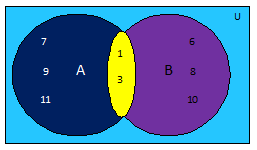CLASS-8
INTERPRETING A VENN DIAGRAM
INTERPRETING A VENN DIAGRAM
In the Venn Diagram shown alongside, the rectangle representing the universal set U contains the elements 7, 9, 11, 1, 3, 6, 8, 10.

So, universal set U = { 1, 3, 6, 7, 8, 9, 10, 11 } and n(U) = 8
The closed region in the rectangle representing the set A contains the elements 1, 3, 7, 9, 11 while that representing the set B contains 1, 3, 6, 8, 10.
A = { 1, 3, 7, 9, 11 } and n(A) = 5
B = { 1, 3, 6, 8, 10 } and n(B) = 5
A U B = { 1, 3, 7, 9, 11 } U { 1, 3, 6, 8, 10 } = { 1, 3, 6, 7, 8, 9, 10, 11 } and n(A U B) = 8
And A ∩ B = { 1, 3, 7, 9, 11 } ∩ { 1, 3, 6, 8, 10 }
= { 1, 3 } and n (A ∩ B) = 2
And, A – B = { 7, 9, 11 } and n (A – B) = 3
Now, B – A = { 6, 8, 10 } and n ( B – A ) = 3
A’ = ( U – A ) = { 1, 3, 6, 7, 8, 9, 10, 11 } – { 1, 3, 7, 9, 11 }
= { 6, 8, 10 }
And n (A’) = 3
B’ = ( U – B )
= { 1, 3, 6, 7, 8, 9, 10, 11 } – { 1, 3, 6, 8, 10 } = { 7, 9, 11 }
And n (B’) = 3
(A U B)’ = U - (A U B)
= { 1, 3, 6, 7, 8, 9, 10, 11 } - { 1, 3, 6, 7, 8, 9, 10, 11 } = φ
And n (A U B)’ = φ
(A ∩ B)’ = U - (A ∩ B)
= { 1, 3, 6, 7, 8, 9, 10, 11 } – { 1, 3 } = { 6, 7, 8, 9, 10, 11 }
And, n (A ∩ B)’ = 6